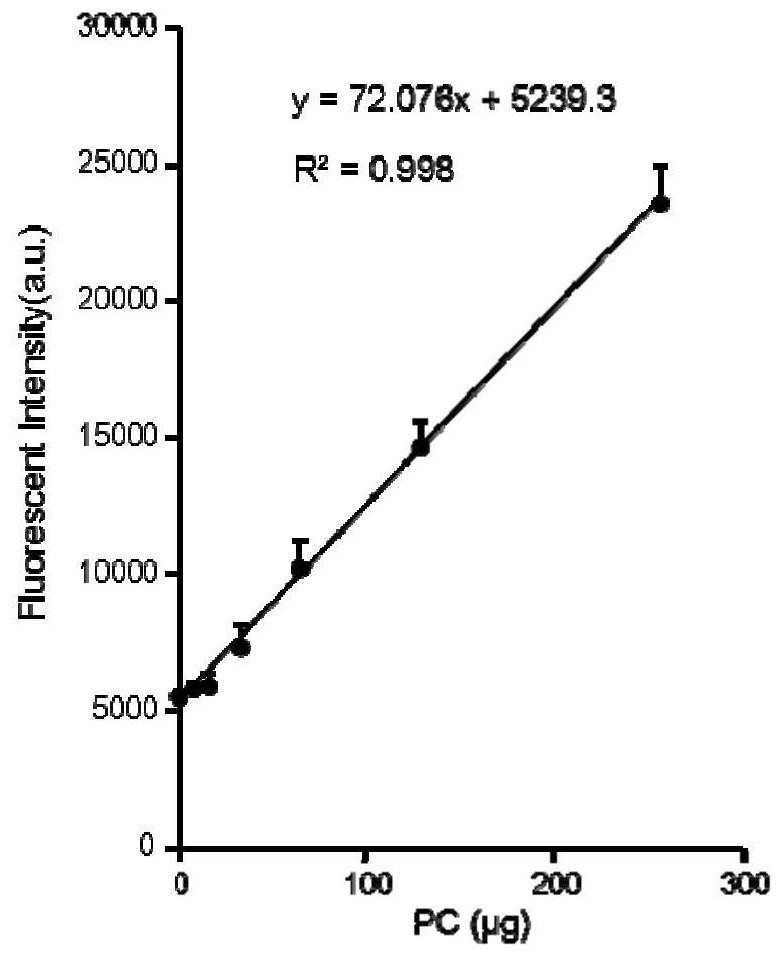Method for evaluating oxidation effect of pulmonary surfactant
An evaluation method and technology of active agent, which can be used in measurement devices, instruments, scientific instruments, etc., can solve the problems of high consumption and low efficiency, and achieve the effects of high accuracy, high throughput, and simple and convenient methods.
- Summary
- Abstract
- Description
- Claims
- Application Information
AI Technical Summary
Problems solved by technology
Method used
Image
Examples
Embodiment 1
[0035] (1) The collected two-dimensional nanomaterials (MoS 2 , GO) were diluted with PBS to different final concentrations (0, 3.12, 6.25, 12.5 and 25 μg / mL), and 500 μL of each concentration was taken for use.
[0036] (2) Weigh 250 μg of unsaturated phospholipid standard PC (18:2), dissolve it in 0.5 mL of chloroform, and add it to a 5 mL glass test tube. The chloroform was blown dry with nitrogen gas, so that the phospholipids formed a uniform film on the glass tube wall. Add different concentrations of nanomaterials into glass test tubes, and set up a blank control group (add 0.5 mL of chloroform containing 250 μg of unsaturated phospholipids, dry the chloroform with nitrogen, and then add 500 μL of PBS), and set 3 parallel samples for each group. . After the nitrogen blowing apparatus was preheated to 37° C., each glass test tube was transferred to the nitrogen blowing apparatus, and oxygen was introduced into the reaction liquid, and the reaction lasted for 2 hours. ...
Embodiment 2
[0039] The collected three-dimensional nanomaterials (Y 2 o 3 、TiO 2 ) were diluted with PBS to different final concentrations (0, 3.12, 6.25, 12.5 and 25 μg / mL), and 500 μL of each concentration was taken for use. Other steps are with embodiment 1. The result is as image 3 shown.
Embodiment 3
[0041] The collected PM2.5 was diluted with PBS to different final concentrations (0, 12.5, 25, 50 and 100 μg / mL), and 500 μL of each concentration was used for later use. Other steps are with embodiment 1. The result is as Figure 4 shown.
PUM
| Property | Measurement | Unit |
|---|---|---|
| thickness | aaaaa | aaaaa |
Abstract
Description
Claims
Application Information
 Login to View More
Login to View More - R&D
- Intellectual Property
- Life Sciences
- Materials
- Tech Scout
- Unparalleled Data Quality
- Higher Quality Content
- 60% Fewer Hallucinations
Browse by: Latest US Patents, China's latest patents, Technical Efficacy Thesaurus, Application Domain, Technology Topic, Popular Technical Reports.
© 2025 PatSnap. All rights reserved.Legal|Privacy policy|Modern Slavery Act Transparency Statement|Sitemap|About US| Contact US: help@patsnap.com



